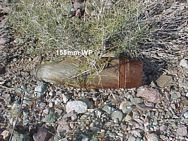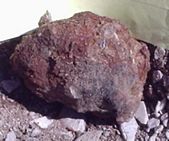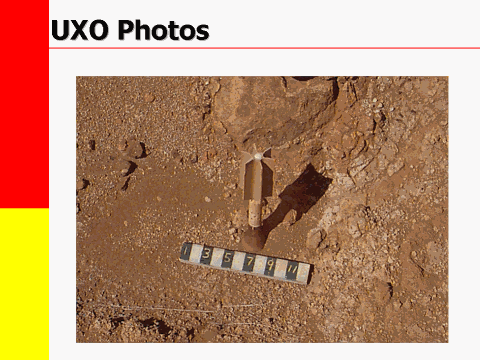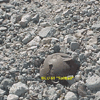An Article In Meteorite-Times Magazine
by Robert Verish
![]()
An Article In Meteorite-Times Magazine
by Robert Verish
UXO Encounters
UXO or UneXploded Ordnance can be encountered even on Public Lands. They are very dangerous and should be reported. A military website provides a form for the general public to report UXO wherever they are encountered.
This month I would like to pass along something that I found while surfing the Net. I found a military website on UXO Safety. It emphasized that UXO should NEVER be handled and that they should be reported. This article provides extracts from that website and a copy of the form that they provided for reporting. If you scour the desert searching for meteorites as much as me, you no doubt have encountered one of these UXO - also known as "Duds”. And you may have been surprised how many are found on public land, and not just on military bases. This military website now gives you the means to have them reported and removed from the area that you and your buddies are searching for meteorites.

Keep in mind, I’m not talking about those 50cal bullets that are found in such abundance in the Franconia area. Those are not considered UXO. But the unspent rounds, those that are complete with the bullet still in brass casing should be treated the same as a UXO. Some of these unfired rounds have been sitting in the desert for over 50 years and the powder in them may have become unstable. For example, there was a recent report in the NEWS about a grade school teacher that had one of these on his desk (he was using it as a PAPERWEIGHT!) and while handling it, the round finally went off and he lost most of his hand. Luckily no kids were injured.
I asked a friend of mine, who lives in the desert, has he heard of any similar incidents. He said without hesitation, “Sure, everyone out here has a STORY that they can tell.” Aside from the stories of crazies using UXO for target shooting, and blowing themselves up in the process, the fact that some UXO can be inadvertently detonated by the transmitted radio frequencies of a CB or two way radio I find to be very troubling.

3.0 UXO SAFETY AND REPORTING PROCEDURES
UXO, whether present in an area by design or by accident, poses the risk of injury or death to anyone in the vicinity. To lessen the danger of UXO hazards and to help prevent placing others at future risk, certain precautions and steps should be taken by anyone who encounters UXO.
"IF YOU DID NOT DROP IT, DO NOT PICK IT UP!"
A person can lessen the danger of UXO hazards by being able to recognize the hazard and by adhering to the following basic safety guidelines (NAVEODTECHDIV 1994):
|
Any UXO discovered in the field should be immediately reported to site Explosive Ordnance Disposal (EOD) personnel. If EOD personnel are not present at the site, the military provost marshal or local law enforcement agency should be notified. The appropriate authority should initially be notified by telephone, with a written report submitted later to document the UXO hazard. Ideally, the exact location should be noted along with the type, condition, estimated size, and distinctive features of the ordnance. A sample reporting format is shown (also can be found at the bottom of the original webpage) in >Appendix B (see below).
FORMAT FOR REPORTING UNEXPLODED ORDNANCE
|
Another website that I found to be very interesting, the UneXploded Ordnance (UXO) Safety website has a simple message. It's message is directed primarily to youngsters. It has many images of UXOs that are educational for adults, as well as kids.
But the main emphasis is on getting across the simple message of :
****************************************
Below are some of the images that appear on the UXO Safety website:

****************************************
Some of the more problematic UXOs are those that were originally used UNDERWATER because they now look very similar to weathered meteorites.
Below are some images of these formerly "underwater" ordnance that look like meteorites:

****************************************
Below are some more of the images that appear on the UXO Safety website:

****************************************
Below are some more of the images that appear on the UXO Safety website:


|
Video Clips |
Visit the Photo Gallery for pictures of different kinds of military munitions and pictures of what UXO might look like.
****************************************Hopefully, this article will help my fellow meteorite hunters and metal detectorists have a better appreciation for the dangers of UXO, and may help prevent any future mishap.
The following "references" are used in this article:
For for more information, please contact me by email:
Bolide*chaser
![]()